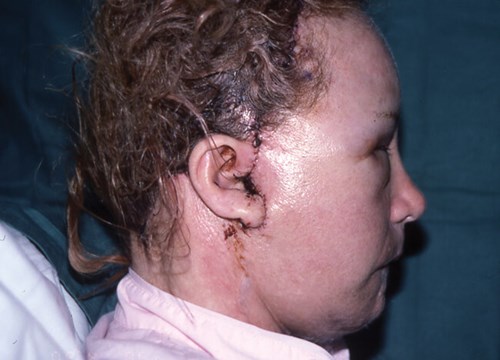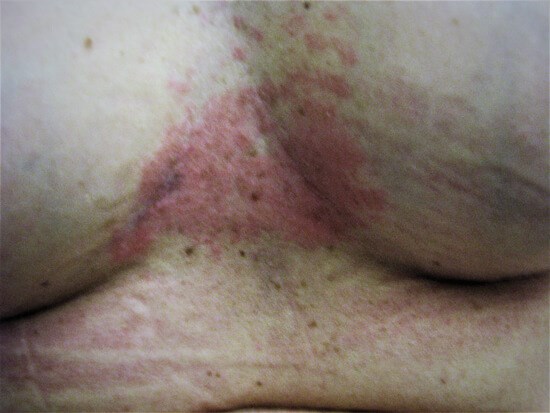
In response to the revelation that allergies now cost the NHS approximately £900 million pounds per year, Professor Frame and colleagues in Chelmsford explain why the mnemonic ‘LIED’ needs to be updated.
In the wake of current affairs and alarming statistics in the UK involving allergies and anaphylactic deaths [1,2], we propose an alteration to the preoperative assessment of allergies.
Medical professionals should note that allergy is the most common chronic disease in Europe [3]. Within Europe, the UK has the greatest allergy prevalence, and in the 20 years leading up to 2012 there was an increase in the rate of anaphylaxis-related hospital admissions by 615% in England and Wales alone [4].
A staggering 44% of British adults now suffer from at least one allergy, and with the inclusion of children, allergies cost the NHS approximately 900 million pounds per year [5]. Consequently, it is important to understand how these statistics can be made less disturbing. The discussion that follows highlights the importance of allergy identification in a medical history when avoiding allergies and anaphylaxis during the perioperative period.
We know of four cases of anaphylaxis in the last year in Chelmsford who had anaphylaxis in response to chlorhexidine, methylene blue dye, cefuroxime and the muscle relaxant rocuronium. All were severe and needed intensive care support with morbidity. Unfortunately, one case was fatal.
Allergic reactions do not always result in anaphylactic shock but can still be severe. In fact, eight million UK citizens live with skin diseases of varying severities [6]. In relation, a case of interest regarding skin allergies was that of a 64-year-old lady with hypothyroidism, who at pre-assessment was known to have skin sensitivity to both water and Elastoplast. This patient had a procedure involving a skin lesion being removed, during which the skin adhesive Dermabond (Ethicon, USA) was applied to close the wounds, with no early or late cutaneous response detected. Following this, in 2014, the patient had a facelift wound closed with Dermabond.

Figure 1: Angioedema of face after facelift; the patient had an allergy to penicillin.
Following application of chloramphenicol ointment to this wound at three weeks the patient immediately developed a rash and was later determined to have a lanolin allergy. Furthermore, in 2016 this patient underwent a Brazilian abdominoplasty, with wound closure assisted by the use of Prineo tape (Ethicon, USA). Although, after 48 hours she developed an allergic rash associated with the Prineo tape that was difficult to manage and persisted for weeks. It was suspected that the patient was allergic to the cyanoacrylate that acts as the adhesive in the Prineo, with the same adhesive being present in both Dermabond and Elastoplast, which the patient was declared sensitive to.
The allergens in Elastoplast are not confined to the cyanoacrylate glue, and as a result it is suspected that the Prineo hypersensitivity rash was caused by the two previous exposures to Dermabond. This lady is clearly an atopic individual, and perhaps all potential allergens should be avoided in the future.
The point to convey from this case in particular is that products used in surgery can contain allergens in any component, in this instance whether it be the material, dye, or adhesive of the Elastoplast. In addition, it is not commonly recognised in the medical profession that cyanoacrylate is the adhesive component of many glues, and thus if a patient declares an allergy to a specific adhesive, they may also be allergic to many other adhesives that could potentially be used in surgery and result in anaphylaxis [7].
Along with the cases described, the 2016 National Audit Project (NAP6) data, and resultant conclusion that the communication between patients, anaesthetists and allergy doctors requires improvement, emphasise the need for more rigorous preoperative assessment of patients’ allergies [8]. NAP6 showed that, of the three million anaesthetics administered in a single year, 47% of anaphylaxis was due to antibiotics, which alarmingly are administered to the majority of patients peri-operatively; when they are incapable of giving any indication of an allergic reaction. Another intriguing result from NAP6 was that almost one in 10 of patients who experienced anaphylaxis were allergic and reacted to chlorhexidine, the exact skin preparation that is recommended by the World Health Organisation (WHO) and the National Institute for Health and Care Excellence (NICE).

Figure 2: Type 4 hyper-sensitivity (contact dermatitis) to cyano-acrylic glue (Dermabond) 10 days postoperatively.
The most documented reactions to chlorhexidine are dermatitis or stomatitis [9,10]. Despite the recommendation, there is not enough evidence in the literature to endorse its use for skin preparation over other products such as iodine-povidone, which has caused only eight cases of anaphylaxis since the 1980s [11,12]. Also, muscle relaxants were found to be responsible for 33% of anaphylactic events. Therefore, given that most of the time antibiotics and skin preparation are administered peri-operatively, the patient does not get a chance to consciously allude to an allergic reaction, thus increasing the risk of anaphylaxis.
“Allergic reactions do not always result in anaphylactic shock but can still be severe”
There is an increasing incidence of anaphylaxis and it has been forecast that half of the European population will suffer from chronic allergies by 2025. This, alongside NAP6, highlights the need for better prevention and mitigation of allergic reactions during a patient’s care pathway [3,4]. It must be made clear that the majority of anaesthetic literature to date has focused on life-threatening anaphylactic shock, whilst delayed hypersensitivities such as allergic contact dermatitis have evaded attention.
However, some patients’ allergies may be idiosyncratic pseudo allergic reactions, similar to irritant contact dermatitis which is not caused by an allergen prompting an IgE- or IgG-mediated reaction. This can potentially be distinguished from allergic contact dermatitis using flow cytometric allergen stimulation tests [13]. A patient may also suggest they have an allergy to iodine, when in fact, if they react to a solution containing iodine, such as povidone-iodine skin preparation, it is the povidone molecules that are more likely to be the responsible allergenic epitopes [14-16].
Currently, when a potential allergy is detected, a patch test can be performed either at the beginning of surgery or in clinic beforehand. In the example of Dermabond, the results are examined prior to dressing application. The problem with doing the test peri-operatively is that allergic contact dermatitis may not arise until two or three days post-procedure [17]. Therefore, heightened awareness of this issue in medical practitioners and patients alike would be progress towards better prevention of allergic reaction and potential anaphylaxis.
A substantial attempt to alter the preoperative assessment of allergies and improve awareness in the process was suggested by Bismil and colleagues in 2007 [18]. The study involved four orthopaedic house officers asking 367 consecutive patients “Do you have any allergies?” and then “Are you allergic to latex, iodine, or Elastoplast?” It was shown that of these patients, 42 disclosed their known allergy when asked the latter, although in response to the former only 16 patients notified the physicians of their allergy. It can be concluded from this study that a substantial number of allergies are not disclosed before surgery, and it is therefore worthwhile during preoperative assessment to employ the mnemonic LIED: Latex, Iodine, Elastoplast, Drugs. Unfortunately, since then, there has been little documented evaluating the use of this mnemonic in clinics when history-taking.
The use of LIED should become an integral part of the care pathway, its use may prompt additions to the mnemonic after discovering more common allergies. We believe there is room to add metals, for example, including nickel and alloys that surgical equipment may be composed of, modifying LIED to LIMED. Interestingly, chlorhexidine allergy was also not included in the study by Bismil et al., possibly because in 2007 the incidence of reactions and anaphylaxis to chlorhexidine was low. Ultimately, LIED is not finite and should be built on.
Further forms of assessment that could be conducted as preventative measures include admitting patients to preoperative allergy clinics for rigorous allergy assessment. However, investment into clinics seems to be required, given that the wait following referral averages over 100 days [4]. Meanwhile, antibiotics should be administered whilst the patient is conscious to confer signs of an allergic reaction that are not visible. Also, as previously alluded to, if patch tests are to be used, they should be done days before surgery so that allergies with a delayed onset of symptoms can be identified. Lastly, patients at risk of having an allergic reaction can be treated preoperation with both corticosteroids and antihistamines, which have been suggested to lower the severity of any potential reaction to certain allergens. Although premedication should not be relied on by physicians as a preventative measure for anaphylaxis as there is no guarantee that it decreases these incidences [19].
Reporting on the incidence of allergic reactions and anaphylaxis is generally poor and needs to be encouraged if we are going to gain any significant data that can potentially be used to safeguard patients. It is therefore safe to assume that the incidence of both allergic reactions and anaphylaxis is higher than suggested by NAP6. Thus, we suggest physicians use the LIED mnemonic, as it can assist in decreasing the incidence, whilst establishing the prevalence of specific allergies. In doing so, this will ensure that data presented in future studies similar to NAP6 will be more representative of the general population.
References
1. Pret a Manger to label products after allergy death. BBC News:
www.bbc.co.uk/news/
business-45731201
2. Cheese allergy death pupil ‘meant no harm’. BBC News:
www.bbc.co.uk/news/
uk-england-london-48124973
3. Tackling the allergy crisis in Europe – Concerted policy action needed. The European Academy of Allergy and Clinical Immunology (EAACL). 2016
www.eaaci.org/documents/
EAACI_Advocacy_Manifesto.pdf
4. Turner P, Gowland M, Sharma V, et al. Increase in anaphylaxis-related hospitalizations but no increase in fatalities: An analysis of United Kingdom national anaphylaxis data, 1992-2012. J Allergy Clin Immunol 2015;135(4):956-63.
5. Allergy Statistics & Facts. Allergy Information. Allergy UK. 2019
www.allergyuk.org/
information-and-advice/statistics
6. It takes seven. British Skin Foundation. 2017
www.ittakesseven.org.uk/about-us
7. Robertson F, Magill L, Davidson C, et al. Cyanoacrylate tissue glues for cutaneous wound closure. In Wound Healing Biomaterials. Magnus Ågren (ed). Woodhead Publishing; 2016:151-68.
8. Harper N, Cook T, Garcez T, et al. Anaesthesia, surgery, and life-threatening allergic reactions: management and outcomes in the 6th National Audit Project (NAP6). Br J Anaesth 2018;121(1):172-88.
9. Abdallah C. Perioperative chlorhexidine allergy: Is it serious? J Anaesthesiol Clin Pharmacol 2015;31(2):152.
10. A summary of selected new evidence relevant to NICE clinical guideline 125 ‘Surgical site infections: prevention and treatment’. National Institute for Health and Clinical Excellence (NICE). 2019
www.nice.org.uk/guidance/ng125/
evidence/b-skin-antiseptics-in-the
-prevention-of-surgical-site-infection
-pdf-6727104399
11. Parkes AW, Harper N, Herwadkar A, Pumphrey R. Anaphylaxis to the chlorhexidine component of Instillagel: a case series. Br J Anaesth 2009;102(1):65-8.
12. WHO Surgical Site Infection Prevention Guidelines. Web appendix 8. 2016
www.who.int/infection-prevention/
publications/ssi-web-appendices/en/
13. Ebo D, Lechkar B, Schuerwegh A, et al. Validation of a two-color flow cytometric assay detecting in vitro basophil activation for the diagnosis of IgE-mediated natural rubber latex allergy. Allergy 2002;57(8):706-12.
14. Lopez Saez MP, de Barrio M, Zubeldia JM, et al. Acute IgE-mediated generalized urticaria-angioedema after topical application of povidone-iodine. Allergol Immunopathol (Madr) 1998;26:23-6.
15. Blanco R, Quirce S, Sanchez-Fernandez C, et al. Sensitization to iodinated polyvinylpyrrolidone. J Allergy Clin Immunol 1998;101:S138.
16. Adachi A, Fukunaga A, Hayashi K, et al. Anaphylaxis to polyvinylpyrrolidone after vaginal application of povidone iodine. Contact Dermatitis 2003;48:133-6.
17. Hagen S, Grey K, Hylwa S. Allergic contact dermatitis to Dermabond™: A case and review of the literature. Wound Medicine 2016;14:25-30.
18. Bismil Q, Bowles C, Edwards M, et al. Detecting Patient Allergy: Beware the LIE. The Annals of The Royal College of Surgeons of England 2007;89(6):603‑4.
19. Caffarelli C, Stringari G, Del Giudice M, et al. Prevention of Allergic Reactions in Anesthetized Patients. Int J Immunopathol Pharmacol 2011;24(3suppl):91-9.
(All website links last accessed August 2019)
Declaration of competing interests: None declared.
COMMENTS ARE WELCOME









